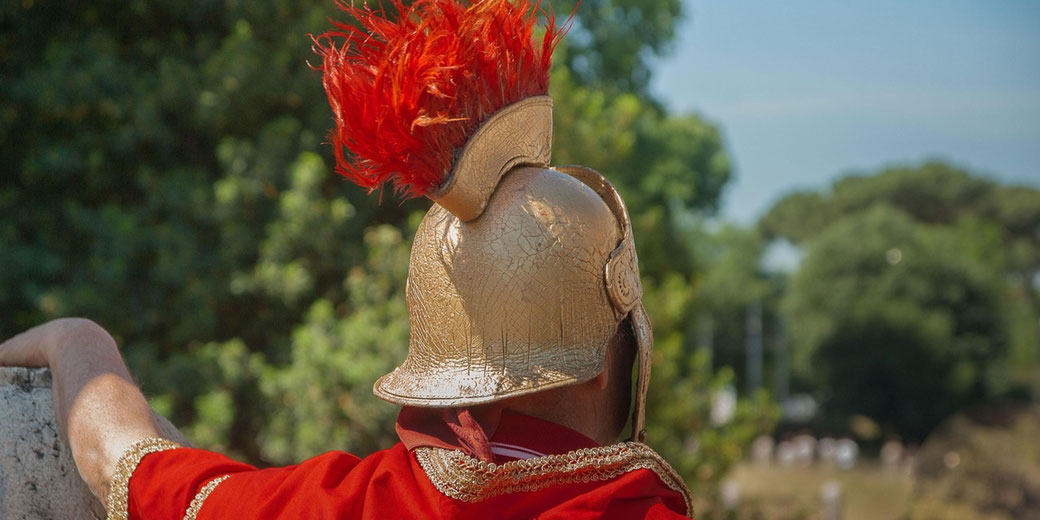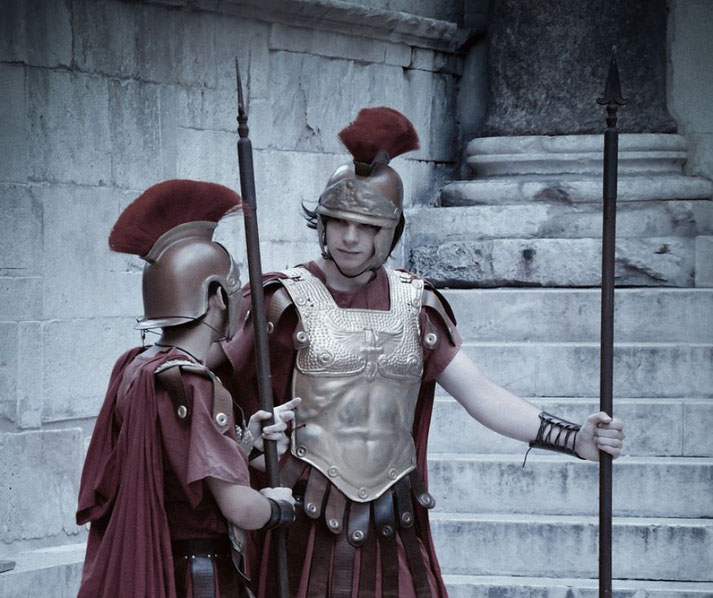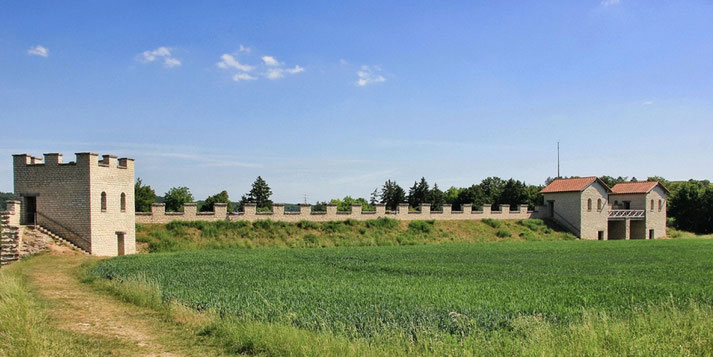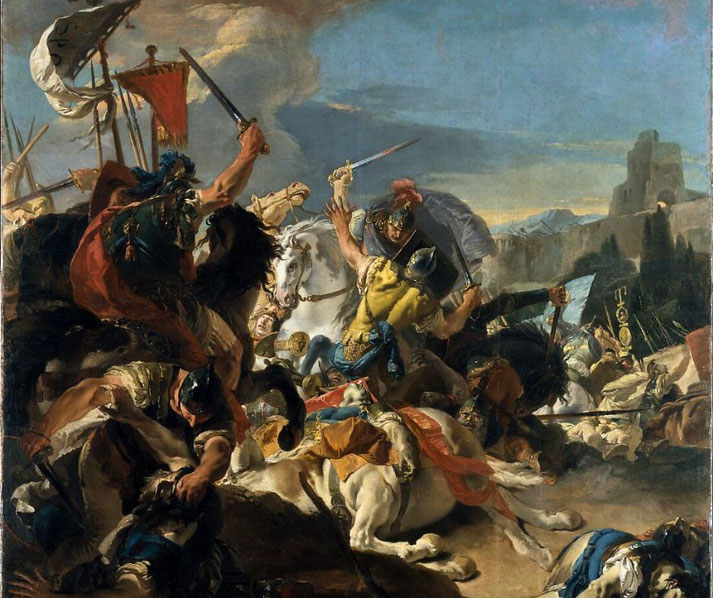A day in the life of a Roman soldier: What was it like?

Beneath towering aqueducts and grand Roman structures, there thrived a force that was the true embodiment of the empire's might: the Roman soldier.
Clad in gleaming armor and marching in disciplined formations, they were more than just warriors; they were symbols of Rome's strength and dominance.
But who were these men behind the shields?
What drove them to march vast distances, to build roads, forts, and to face death in distant lands?
How did they live, train, and find solace amidst the chaos of war?
Sign up today! How to become a Roman soldier
The Roman Empire, as it expanded and sought dominance, required a vast and efficient military machine.
This need gave rise to a rigorous recruitment process, ensuring that the legions were continually replenished with capable men.
Initially, Roman soldiers were citizens called upon to defend their city and its territories.
However, as the empire grew, so did its need for a more professional and standing army.
In 107 BCE, the Marian reforms were introduced by Gaius Marius and marked a significant shift.
No longer was the Roman army just a band of property-owning citizens; it transformed into a force of career soldiers, often drawn from the poorer strata of society, who saw the military as a means to social mobility and a steady income.

Welcome to basic training
Once recruited, these men were thrust into a world of intense training and discipline.
A new recruit's life was drastically altered as he was molded into a legionary. Training was not merely about physical prowess; it was about instilling a mindset.
The raw recruits learned to wield the gladius and pilum with deadly precision, but they also internalized the values of loyalty, discipline, and sacrifice.
Days were spent practicing formations, mock battles, and endurance marches. The training grounds echoed with the clatter of weapons and the shouts of centurions, ensuring that each man knew his place in the vast military machine and could execute orders without hesitation.
Becoming part of the team
Yet, beyond the physical and tactical training, there was an underlying purpose: forging a bond among the soldiers.
The Roman military genius was not just in its tactics or equipment but in its ability to create a cohesive unit out of diverse individuals.
Men from different regions, with varied backgrounds, were transformed into brothers-in-arms.
They shared tents, broke bread together, and watched each other's backs in the heat of battle.
This camaraderie, forged in training and strengthened in combat, was the true strength of the Roman legions.
It ensured that when they marched, they did so as one, an indomitable force representing the might of Rome.
Your daily routine
The life of a Roman soldier, while punctuated by battles and campaigns, was largely defined by a structured daily routine.
As dawn broke over the Roman camp, the horn's call would rouse the legionaries from their slumber.
This was not a gentle awakening; it was a summons to the day's duties. The first order of business was the morning muster.
Soldiers would assemble in their respective units, standing in neat rows, awaiting inspection.
This was a crucial ritual, ensuring that every man was accounted for, and that weapons and armor were in prime condition.
Any neglect could mean the difference between life and death on the battlefield, and the Roman military left nothing to chance.
Following the muster, the legionaries would engage in rigorous training exercises. Even seasoned veterans, with numerous campaigns under their belts, were not exempt from these daily drills.
The Roman military's efficiency lay in its discipline and the unwavering commitment to honing skills.
Soldiers practiced hand-to-hand combat, simulated battle scenarios, and worked on maintaining their physical fitness.
The clanging of swords, the rhythmic thud of shields, and the shouted commands of officers filled the air, a testament to the relentless pursuit of martial excellence.
However, the day was not all work and no play. After the morning's exertions, soldiers would break for their main meal, often a hearty stew accompanied by bread, washed down with a sour wine.
This was a time for relaxation and camaraderie, as stories, jokes, and news were exchanged among the men.
The afternoon might see lighter duties, perhaps guard shifts or maintenance tasks around the camp.
As the sun dipped below the horizon, the camp would settle into a quieter rhythm. Evening meals were consumed, prayers offered to the gods, and as night enveloped the camp, the soldiers would retreat to their tents.
Not just fighting... Here are the jobs you might do
One of the primary duties of a legionary was to stand guard. Whether stationed at the towering gates of a fort, along the vast stretches of Hadrian's Wall, or at the entrance of a commanding officer's tent, the act of standing watch was a sacred responsibility.
It was a testament to the soldier's discipline and commitment, ensuring that threats, both external and internal, were kept at bay.
Night watches were particularly crucial, with soldiers relying on passwords to identify friend from foe, a system overseen by the tesserarius, an officer responsible for the daily watchword.
Beyond the confines of the camp, Roman soldiers often found themselves tasked with patrol duties.
These patrols were essential for gathering intelligence, scouting potential threats, and ensuring the safety of Roman territories.
In the vast expanse of the empire, these patrols were the eyes and ears of Rome, a constant reminder of its omnipresence.
Yet, not all duties were centered around combat or defense. Roman soldiers were also engineers, builders, and laborers.
They constructed roads that connected the empire, forts that solidified its borders, and bridges that spanned its rivers.
The famed Roman roads, straight and durable, were often built by the very soldiers who would march on them.
This dual role of soldier and builder was a strategic masterstroke, allowing rapid deployment and movement of troops.
Moreover, it instilled a sense of ownership and pride in the infrastructure they built, which would serve both their comrades and future generations.
Your home away from home: Life in a Roman fort
The castrum, or Roman fort, was a home away from home for the legionaries stationed within its walls.
These forts, strategically dotted across the vast expanse of the empire, served as both defensive bastions and centers of Roman culture and administration in newly conquered or frontier territories.
The fort was meticulously planned, with broad streets like the Via Praetoria cutting through its heart, leading from the main gate to the headquarters, or the Principia.
This building was the administrative and religious center of the fort, housing the legion's standards, the shrine for daily offerings, and the offices of commanding officers.
Adjacent to the Principia, one would often find the horrea, or granaries, vital for storing the provisions that kept the legion fed and functional.
Yet, the castrum was not just about administration and storage. The barracks, where the soldiers lived, were a hive of activity.
Arranged in a series of contubernia, each housing unit accommodated eight men, who lived together and bonded over their experiences.
Beyond the barracks, the castrum often boasted workshops, bathhouses, and sometimes even amphitheaters.
These amenities provided the soldiers with a semblance of civilian life, allowing them to relax, socialize, and engage in trade or crafts.
The presence of traders, craftsmen, and often families of the soldiers added to the bustling atmosphere, making the castrum a lively community rather than just a military installation.

The harsh punishments when you broke the rules...
The backbone of the Roman military's unparalleled success was its unwavering discipline.
This discipline, however, came at a price, enforced through a strict code of conduct and a series of harsh punishments for those who dared to transgress.
The Roman legions were not merely a fighting force but a meticulously organized institution in which order, hierarchy, and strict discipline governed every aspect of life.
This rigorous discipline ensured the smooth functioning of the legions.
Minor infractions, such as negligence in maintaining equipment or tardiness for duty, often resulted in fines or a reduction in rations.
However, more severe offenses, like theft, insubordination, or desertion, demanded harsher retribution.
Flogging, a common punishment, was administered publicly, serving as a deterrent to others.
The leather whip, or flagrum, was a fearsome instrument often with metal or bone fragments embedded in it. A soldier subjected to its lashes bore the scars as a lifelong reminder of his transgression.
Among all the punishments, one stood out for its sheer brutality and psychological impact: decimation.
Reserved for units guilty of cowardice or mutiny, this punishment required every tenth man, chosen by lot, to be executed by his comrades.
The randomness of the selection process instilled a profound fear, ensuring that the collective bore the responsibility for the actions of a few.
The survivors, after witnessing or participating in the execution of their brothers-in-arms, were often forced to camp outside the fort's protective walls, a symbolic and literal ostracization.
The importance of religion and superstitions
Religion and superstition played a pivotal role in the life of a Roman soldier, intertwining with their daily routines and shaping their perceptions of the world around them.
The Roman pantheon, vast and varied, offered a deity for almost every aspect of life, and the military was no exception.
Mars, the god of war, was venerated with particular fervor among the legions. As the divine protector of soldiers and a symbol of martial prowess, his favor was sought before embarking on campaigns and during significant battles.
Temples dedicated to Mars dotted the empire, and within the confines of the castrum, altars were often erected in his honor.
Yet, the soldiers' religious practices were not limited to the official Roman gods. The legions, drawing men from various parts of the empire, became a melting pot of religious beliefs and practices.
Deities from conquered lands, such as the Persian god Mithras, found a following among the Roman troops.
The cult of Mithras, with its rituals of initiation and its emphasis on bravery and camaraderie, resonated deeply with the soldiers of lower ranks, leading to its widespread popularity.
Superstition, too, was deeply ingrained in the military psyche. Omens, dreams, and natural phenomena were often interpreted as signs from the gods, guiding the decisions of generals and the morale of the troops.
The flight of birds, the behavior of animals, or even a chance occurrence before a battle could be seen as portents of victory or defeat.
One of the most revered symbols in the Roman military was the eagle, or aquila. Each legion possessed its own aquila, a golden eagle mounted on a standard.
It was not just a symbol of the legion's honor and pride but was believed to hold the protective spirit of the unit.
Losing this standard to the enemy was considered a catastrophic event, steeped in both shame and superstitious dread.
What to expect on the day of battle...
The day of battle was a culmination of rigorous training, strategy, and the raw emotions of anticipation and fear.
As dawn broke, the Roman camp would be abuzz with activity. Soldiers would don their armor, meticulously checking each piece for any flaws.
The weight of the lorica segmentata, the clinking of the metal, and the firm grip of the scutum shield served as tangible reminders of the impending confrontation.
The air would be thick with tension, punctuated by the sharp commands of centurions and the murmured prayers of soldiers seeking favor from the gods.
Before the battle commenced, generals and tribunes would address their troops, delivering rousing speeches to bolster morale and remind them of their duty to Rome.
These speeches, often invoking the glory of past victories and the honor of the Roman name, were crucial in galvanizing the soldiers, transforming individual fears into a collective drive.
As formations were set, the Roman discipline came to the fore. Legionaries would form tight ranks, with auxiliaries and cavalry taking their designated positions.
The meticulous organization ensured that each soldier knew his role and place.
As the two opposing forces approached each other, the battlefield would resonate with the sounds of war horns, the shouts of commanders, and the rhythmic march of armored feet.
The initial moments were often a test of wills, with both sides employing psychological tactics, from war cries to the display of banners, aiming to intimidate the enemy.
Then, with the hurling of the first pilum, the battle would commence in earnest. Amidst the chaos of clashing swords and the cries of combatants, the Roman soldier relied on his training, the orders of his officers, and the support of his comrades.
The bond forged in the castrum and on long marches now became the lifeline, as soldiers fought, not just for Rome, but for the brother beside them.

How did people leave the Roman army?
Leaving the Roman army, much like joining it, followed a structured process dictated by tradition, rules, and imperial needs.
The typical service tenure for a Roman legionary in later periods was 25 years, but it could extend depending on the circumstances of the empire and its military needs.
After fulfilling their service, soldiers were formally discharged in a process known as missio honesta, or honorable discharge.
This was a significant milestone in a soldier's life, marking the transition from a life of rigorous discipline and duty to one of relative civilian freedom.
Upon discharge, non-citizen soldiers would receive a 'diploma,' a bronze document that confirmed his completed service and granted him Roman citizenship.
This was a transformative honor, elevating a soldier's social status and providing him with legal and economic benefits.
Alongside citizenship, retiring soldiers were often given a plot of land, sometimes in the newly conquered territories.
This land grant served a dual purpose: it acted as a pension for the veteran, ensuring his economic wellbeing, and simultaneously, by settling veterans in new or restive regions, Rome effectively established pockets of loyal, experienced individuals who could act as a stabilizing influence.
However, not all exits from the army were marked by such honor and reward. Some soldiers, due to severe injuries or health issues, might receive a medical discharge, allowing them to leave before completing their full term.
By contrast, those guilty of grave misconduct or dereliction of duty faced dishonorable discharge.
Such individuals were stripped of their privileges and often faced societal disdain.
Regardless of the circumstances of their departure, life after the army presented challenges for many veterans.
While some transitioned into farming or trade, using the skills and networks gained during their service, others struggled with the psychological and physical scars of warfare.
The camaraderie and structure of the military life were hard to replace, and many veterans found solace in forming associations or joining veteran communities, where shared experiences bridged the gap between the world of the legions and the civilian realm.
In these gatherings, tales of past campaigns were recounted, bonds rekindled, and the legacy of their service to the mighty Roman Empire was celebrated and remembered.
What do you need help with?
Download ready-to-use digital learning resources
Copyright © History Skills 2014-2025.
Contact via email
With the exception of links to external sites, some historical sources and extracts from specific publications, all content on this website is copyrighted by History Skills. This content may not be copied, republished or redistributed without written permission from the website creator. Please use the Contact page to obtain relevant permission.





